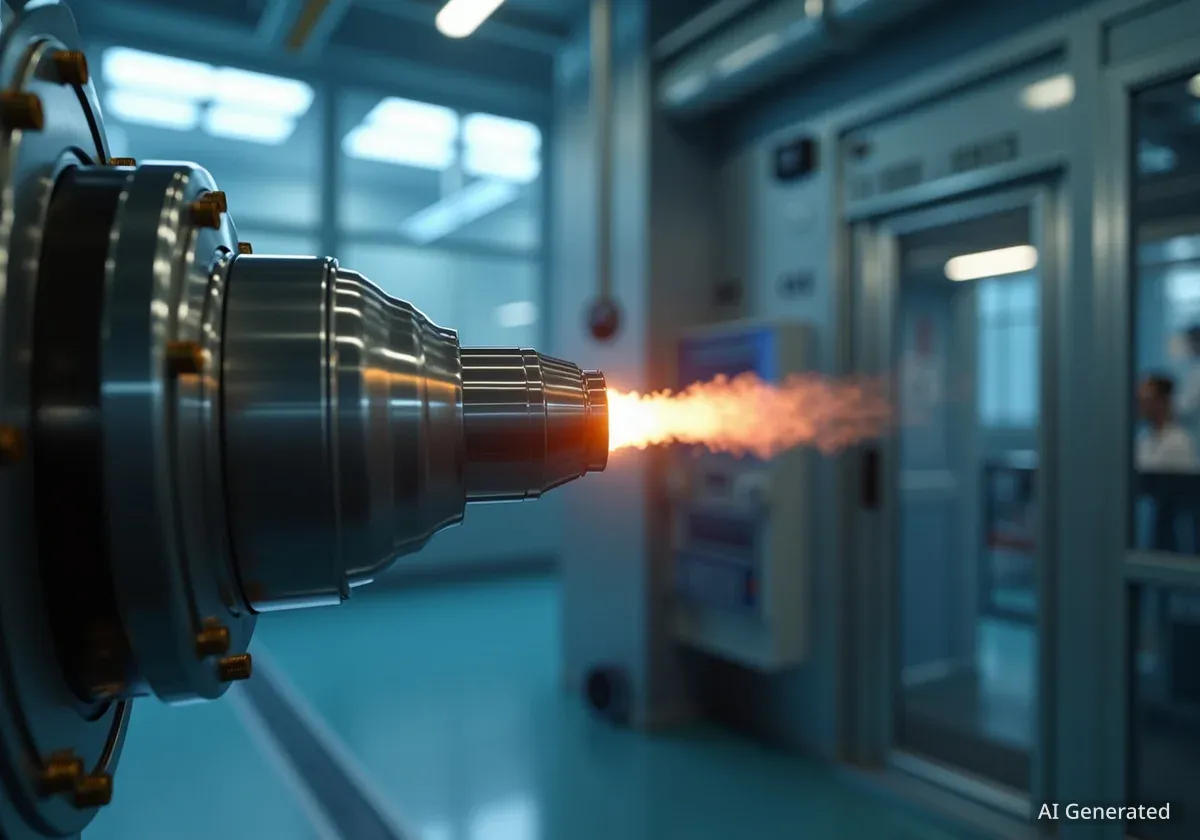Portal Space Systems has successfully completed a key performance test of its solar thermal propulsion system, designed for its multi-role spacecraft, Supernova. The trial, conducted in a vacuum chamber at the company's Washington facility, validated the performance of its patented, 3D-printed heat exchanger thruster under simulated space conditions.
The component, named Flare, operated at full power and high temperatures, confirming performance models and marking a significant step toward enabling rapid orbital maneuvers for future commercial and national security missions.
Key Takeaways
- Portal Space Systems successfully tested its 3D-printed Flare thruster in a space-like vacuum environment.
- The test confirmed the thruster's ability to operate at full power and high temperatures, matching performance predictions.
- The technology is central to the Supernova spacecraft, designed for rapid movement between Earth orbits and cislunar space.
- The system uses storable, non-cryogenic ammonia as a propellant, which supports on-orbit refueling and a longer operational life.
Thruster Performance Validated in Vacuum Test
Portal Space Systems recently conducted a critical ground test of its core propulsion technology. The evaluation took place at its facility in Washington, where the company's patented heat exchanger (HEX) thruster was subjected to operational temperatures inside a specialized vacuum chamber.
This environment was designed to simulate the harsh conditions of space. During the test, the thruster, known as Flare, achieved full-power operation at high temperatures. According to the company, the results successfully confirmed its predicted performance metrics under these flight-like conditions.
This validation is a crucial milestone for the development of the Supernova spacecraft, which will rely on this propulsion system for its primary functions. The successful test moves the technology from a theoretical concept to a proven hardware system ready for further integration.
Advanced Maneuverability with Solar Thermal Propulsion
The Flare thruster is the engine behind the Supernova spacecraft's planned maneuverability. Portal Space Systems states the technology will allow for unprecedented speed in repositioning assets in space. The system uses a single, storable monopropellant—ammonia—which is non-cryogenic, simplifying storage and handling.
Projected Transit Times
- Low Earth Orbit (LEO) to Medium Earth Orbit (MEO): A few hours
- Medium Earth Orbit (MEO) to Geosynchronous Orbit (GEO): Under one day
- Low Earth Orbit (LEO) to Cislunar Space: A few days
These capabilities represent a significant improvement over conventional propulsion systems. Jeff Thornburg, CEO of Portal Space Systems, highlighted the strategic importance of this agility.
"With maneuverability becoming a defining advantage in space operations, Supernova is built to give national security and commercial operators the ability to reposition, respond, and persist across orbits. This propulsion system unlocks mission tactics and timelines that traditional chemical or electric systems simply can’t support."
The design philosophy behind Supernova is centered on movement and responsiveness, contrasting with traditional satellites primarily built to maintain a fixed position. This allows for dynamic mission profiles across LEO, MEO, GEO, and cislunar orbits.
Innovation Through Additive Manufacturing
While the concept of solar thermal propulsion (STP) is not new, its practical application has been limited. Research into STP has been ongoing since the 1960s by government agencies like NASA and the U.S. Air Force, but it has largely remained an experimental field.
What is Solar Thermal Propulsion?
Solar Thermal Propulsion (STP) is a technology that uses concentrated solar energy to heat a propellant, such as ammonia. The heated, high-pressure gas is then expelled through a nozzle to generate thrust. It offers a middle ground between high-thrust chemical rockets and high-efficiency electric propulsion systems.
Portal Space Systems is the first commercial entity to advance the concept into a flight-representative system. The company's breakthrough comes from a combination of modern technologies, including additive manufacturing (3D printing), advanced materials, and a novel heat exchanger design.
Using 3D printing for the Flare thruster allows for complex internal geometries that would be difficult or impossible to create with traditional manufacturing methods. This intricate design is key to efficiently transferring heat to the propellant, which is essential for making the STP system viable for real-world missions.
System Design for Longevity and Flexibility
The propulsion architecture developed by Portal offers several operational advantages beyond speed. Because the system does not rely on combustion and uses a non-cryogenic propellant, it is inherently more flexible and sustainable for long-duration missions.
Key features of the system include:
- Refuelable Architecture: The use of storable ammonia supports the potential for on-orbit refueling, extending the spacecraft's operational life.
- Extended Mission Life: The system is designed for an on-orbit life of over 5 years, providing greater long-term value for operators.
- Reduced Complexity: By avoiding cryogenic propellants, the system eliminates the need for complex and heavy insulation and thermal management systems, reducing overall spacecraft complexity.
These design choices are intended to provide commercial and government operators with greater mission flexibility. The ability to refuel and reposition a spacecraft quickly could fundamentally change how satellite constellations are managed and how space-based assets respond to emerging needs or threats.





